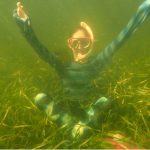Jamila Roth is a PhD student in the UF School of Natural Resources and Environment, and she recently answered some questions about her research interests and efforts.

What is the goal of your PhD research?
The overarching goal of my research is to better understand how environmental change, including tropicalization, impacts seagrass meadows in the Gulf of Mexico (GoM). Tropicalization (i.e. migration of tropical species away from the equator due to warming temperatures) has resulted in more herbivores, including green turtles, manatees, and emerald parrotfish, living in the GoM. The impact of these herbivores on seagrass function and persistence will depend on herbivore feeding behavior, seagrass anti-herbivore defenses, and seagrass resilience.
As a PhD candidate in Dr. Laura Reynolds’ lab, I am investigating (1) seagrass response to warming and herbivory and (2) the factors influencing herbivore feeding behavior, thereby including multiple trophic levels and environmental variables in my research. There are several seagrass species in the GoM, and therefore, I am also interested in whether these species respond differently to environmental change, and if greater seagrass species diversity would increase seagrass resilience following heat waves and herbivory. To answer these questions, I am conducting laboratory experiments at the UF/IFAS Nature Coast Biological Station along with field experiments. This work is funded through the CERF Legacy Fund, the UF/IFAS NCBS/Florida Sea Grant Scholarship, and the Biogeochemistry Graduate Fellows Program (sponsored by the Soil and Water Sciences Department and Wetland Biogeochemistry Laboratory). My goal is to conduct research that can be applied to seagrass conservation and restoration programs and to make all parts of the research process accessible to the local community.
How has your work involved local communities so far?
Engaging with local communities and sharing my love for coastal ecology is important to me, and I was fortunate to receive a Thompson Earth Systems Institute grant to support this work. In one project, I designed and led seagrass-focused activities that are aligned with Florida learning standards at afterschool science clubs, documenting student knowledge before and after the activities and reporting the activities and findings in a publication. I also created an interactive exhibit about seagrass ecosystems that can be viewed in the UF/IFAS NCBS Discovery Center.
How does your work support decision-making or management of coastal resources?
Seagrasses provide many valuable services, including carbon sequestration, sediment stabilization, nutrient cycling, and habitat for fishery species as well as endangered species. However, seagrasses are declining globally due to human activity and climate change, and seagrass loss has direct economic, cultural, and ecological impacts. Through my research, I aim to provide insight into how changing environmental conditions (warming and increased seagrass consumption by herbivores) will together impact seagrass meadows, which can inform seagrass management strategies. By investigating how seagrass species diversity impacts ecosystem resilience and stability, my research will also improve our understanding of how competition and facilitation among seagrass species could influence and potentially benefit seagrass restoration strategies. In other words, I am studying whether planting multiple species of seagrass would make restoration efforts more successful.
What is the most interesting thing that you have discovered through your research?
I am fascinated by herbivore feeding decisions and the many factors influencing these decisions. When selecting plants to eat, herbivores are often influenced by plant texture and taste (i.e. chemistry). Since overgrazing by herbivores can decimate seagrass meadows, it is important to understand the basis of these feeding decisions. While multiple studies have found that herbivores frequently prefer seagrasses with higher nitrogen concentration, fewer studies have focused on how phosphorus (P) impacts herbivore feeding behavior. As P content may influence seagrass taste or texture, I wanted to test whether herbivores prefer seagrass with higher P concentration.
Using a natural gradient in P concentration along the GoM, I found that sea urchins frequently preferred seagrass with higher P concentration, indicating that P availability could influence sea urchin grazing patterns. Additionally, these results demonstrate that nutrient history could impact the effects of tropicalization (and larger herbivore populations) on seagrass ecosystems. More information about these preliminary results can be found in this blog post, and I am excited to work with Dr. Todd Osborne at the Whitney Laboratory for Marine Bioscience to conduct similar experiments using herbivorous emerald parrotfish, as this species is increasingly abundant in the GoM due to tropicalization.